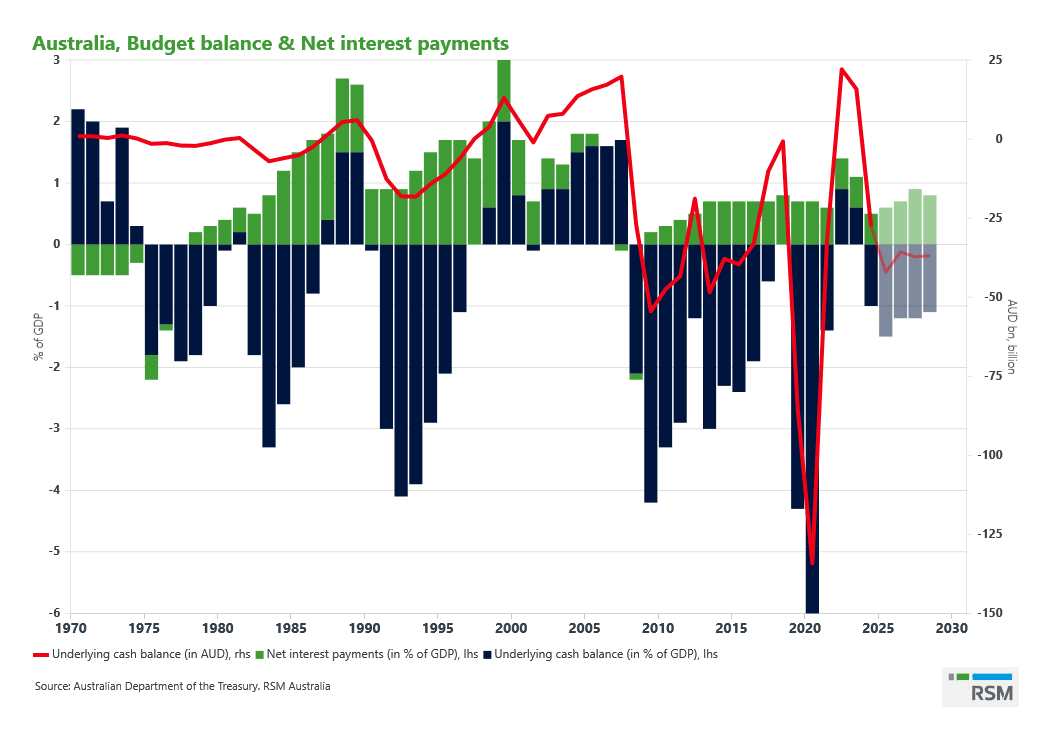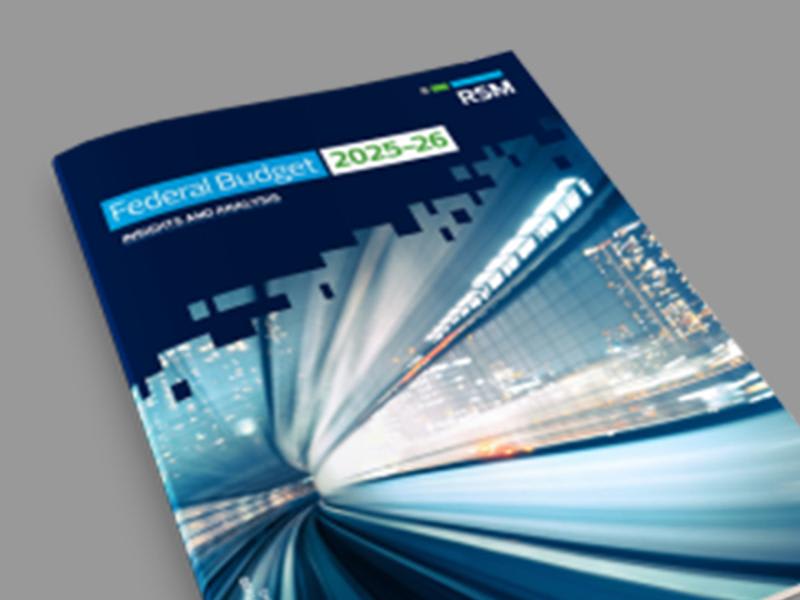AUTHOR
Insights from the 2025-26 Federal Budget
The Federal Budget introduces a mix of tax cuts, subsidies, and spending measures aimed at easing cost-of-living pressures for households and operational costs for businesses. While these measures offer short-term relief, a bigger question remains: how sustainable is this approach in the long run?
Australia’s underlying cash deficit is expected to hit $42.1bn, or 1.5% of GDP, by the end of the 2025-26 financial year. For the current fiscal year, the deficit is forecast at $27.6bn (1% of GDP), and in 2026-27, it’s expected to grow to A$35.7bn (1.2% of GDP). The Government doesn’t anticipate a return to surplus until 2035-36. Net debt is expected to increase from 19.9% of GDP this year to 21.5% by mid-2026, reaching 23.1% by 2028-29.

The Government has benefited from consecutive budget surpluses due to high commodity prices and a strong labour market.
However, global economic pressures mean that the outlook for commodity prices is more subdued. Over the next year, key commodities are expected to drop from their high levels—iron ore to $60 per ton, metallurgical coal to $140 per ton, thermal coal to $70 per ton, and LNG prices to stabilise at $10 per MMBtu.
Economic forecasts from Treasury paint a mixed picture, factoring in global uncertainties.
![]() Although tax cuts may boost household consumption, business investment prospects remain cautious. Mining investment is expected to recover, but non-mining investment remains flat.
Although tax cuts may boost household consumption, business investment prospects remain cautious. Mining investment is expected to recover, but non-mining investment remains flat.
GDP is projected to grow 1.5% for the current fiscal year and 2.25% in 2025-26. Inflation is expected to rise to 3% in 2025-26, slightly higher than the previous forecast, but Treasury expects inflation to return to the target band six months earlier than expected. Unemployment is projected to peak at a lower rate of 4.25%, and wage growth is forecast to rise modestly by 3.25% in 2025-26. Migration is expected to ease, with 335,000 people projected to arrive in 2024-25, followed by 260,000 in 2025-26 and 225,000 in 2026-27.
For households, key budget measures include tax cuts for all taxpayers, with the lowest tax bracket reducing from 16% to 15% in 2026, and further to 14% in 2027. While this provides some relief, there’s concern that it could spur demand-driven inflation. Households will also benefit from a $150 electricity rebate, but this is a short-term fix that doesn't address the structural issues of high energy prices. Healthcare support, such as bulk-billing incentives and extra Medicare funding, is one relief measure that we wholeheartedly celebrate.
There’s also help for young Australians through reduced student debt and increased support for first-home buyers via the expanded Help to Buy scheme. However, unless construction sector productivity improves, the ongoing housing undersupply could drive up house prices as demand increases due to these subsidies.
There is some support for small businesses through a range of initiatives.
Energy bill relief has been extended until the end of 2025, offering rebates of up to $150 for one million eligible small businesses. Over the past three budgets, this relief has helped businesses save up to $800 on energy bills. Additionally, the Energy Efficiency Grants program is distributing $56.7m to over 2,400 businesses for energy upgrades, such as replacing inefficient appliances and improving heating systems.
Support for the hospitality and alcohol sectors includes pausing excise duty increases on draught beer and alcohol products, expected to reduce receipts by $165 million over five years. The Government's tax cuts are also benefiting approximately 1.5 million sole traders by providing tax relief for all taxpayers.
To improve fairness in the market, the Government is collaborating with states and territories to extend protections against unfair trading practices for small businesses. Furthermore, $7.1m is allocated over two years to enhance the Australian Competition and Consumer Commission's enforcement of the Franchising Code, ensuring protections against unfair contract terms and trading practices for businesses governed by the Code.![]()
In the realm of digital and cybersecurity support, the Government has committed over $60m to help small businesses improve their digital capabilities and protect against cyber threats.
Programs like Digital Solutions, Cyber Wardens, and Cyber Health Check help businesses adopt digital tools and build cyber resilience.
The ban on non-compete clauses for workers earning up to $175,000 is aimed at increasing job mobility. Non-compete clauses help SMEs protect business interests by preventing employees from taking trade secrets, clients, or knowledge to competitors, ensuring stability and justifying investment in training. However, they can also deter talent, create enforcement challenges, lower morale, and face increasing legal scrutiny. For SMEs, the key is balancing protection with flexibility—using tailored agreements like confidentiality clauses or non-solicitation terms to safeguard assets without overly restricting employee mobility.
In terms of productivity and inflation, while the tax cuts and rebates offer immediate relief, they don't directly boost long-term productivity.
Growth overall depends on business investment, innovation and workforce development. Increased government spending, particularly in social services and infrastructure, may support demand, but it also adds to fiscal pressure. With the Government’s deficit set to grow, concerns about sustainable public finances are rising.
The Reserve Bank of Australia (RBA) faces the challenge of balancing inflation control with economic growth. While inflation is easing, continued high spending and energy subsidies could make it harder for the RBA to cut interest rates further—a risk it is well aware of.








